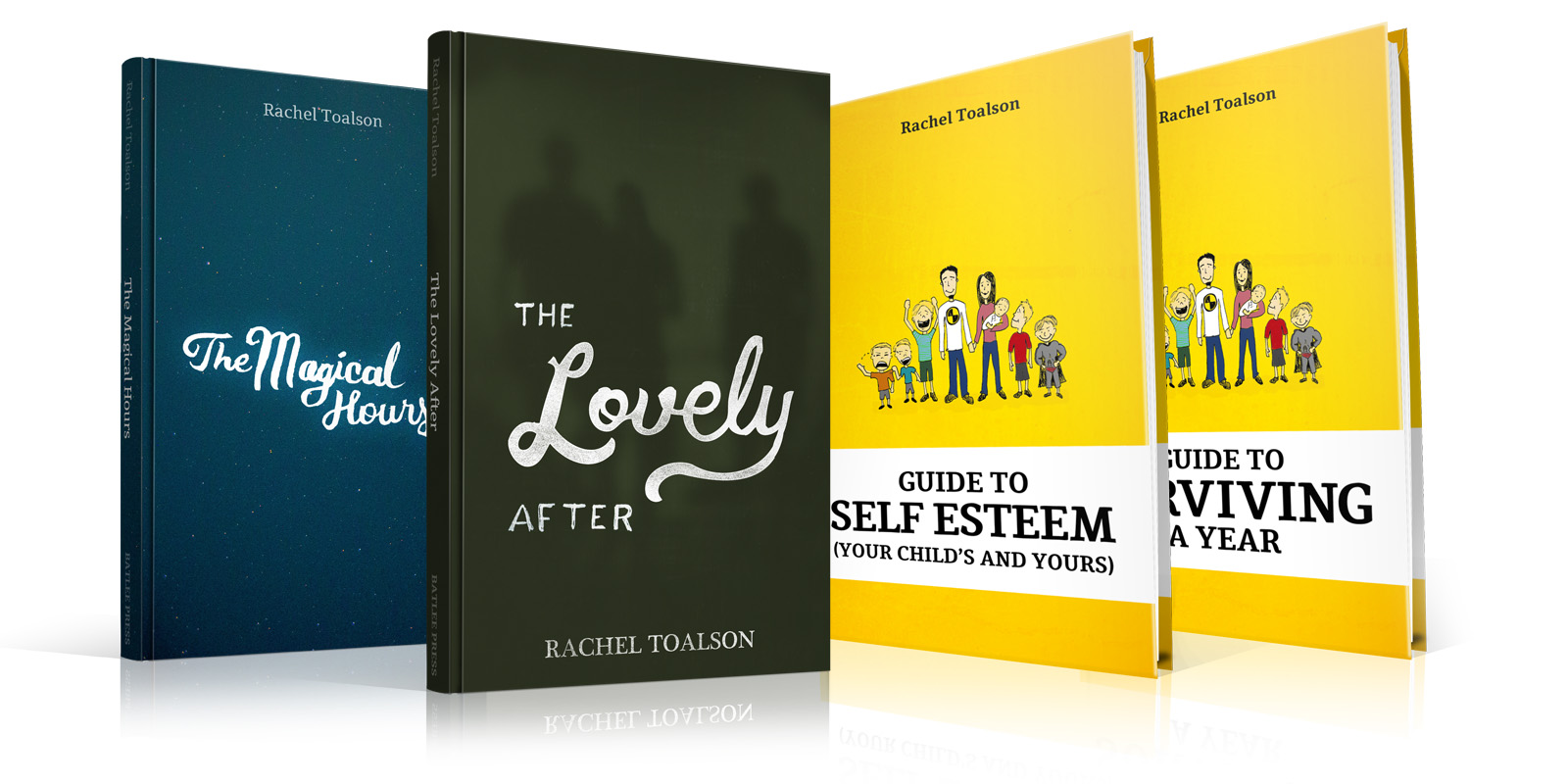
by Rachel Toalson | On My Shelf
On my shelf this week:
Below, by Meg McKinlay
Little Women, by Louisa May Alcott
To Show and to Tell: The Craft of Literary Nonfiction, by Phillip Lopate
The Hero with A Thousand Faces, by Joseph Campbell
This week I’ve got a new middle grade novel, one of my favorite old classics and two (really great) writing books. Lopate is an essay authority who compiled The Art of the Personal Essay, which is also on my list, because I’m always trying to become better at my craft. Campbell is a classic authority on writing, and because I’ve read some of his other works, this one has been on my list for a while. I’m glad I’m finally getting around to it.
Best quotes so far:
“It was funny when you realized that none of the thoughts running through your head had made it into the outside world, that they were yours and yours alone.”
Meg McKinlay
“I am not afraid of storms, for I am learning how to sail my ship.”
Louisa May Alcott
“I’ve got the key to my castle in the air, but whether I can unlock the door remains to be seen.”
Louisa May Alcott
“In the best nonfiction, it seems to me, you’re always made aware that you are being engaged with a supple mind at work. The story line or plot in nonfiction consists of the twists and turns of a thought process working itself out.”
Phillip Lopate
“If consciousness isolates, it also heals and consoles. In my own writing I am trying to say, among other things, ‘This is my consciousness, now don’t feel so guilty about yours. If you have perverse, curmudgeonly, conflicted, antisocial thoughts, know that others have them, too.'”
Phillip Lopate
“Instead of clearing his own heart the zealot tries to clear the world.”
Joseph Campbell
“Not all who hesitate are lost. The psyche has many secrets in reserve. And these are not disclosed unless required.”
Joseph Campbell
Read any of these? Tell us what you thought.

by Rachel Toalson | Fiction in Forty
When the sun came up that day we were ready for it. We weren’t ready for the snow, though. We did not have the proper gear. They came, and all we could do was slip, slide and try to survive.
Ongoing challenge: Find (or take) a picture. Write exactly 40 words about it. Post.
(Great practice for brevity.)
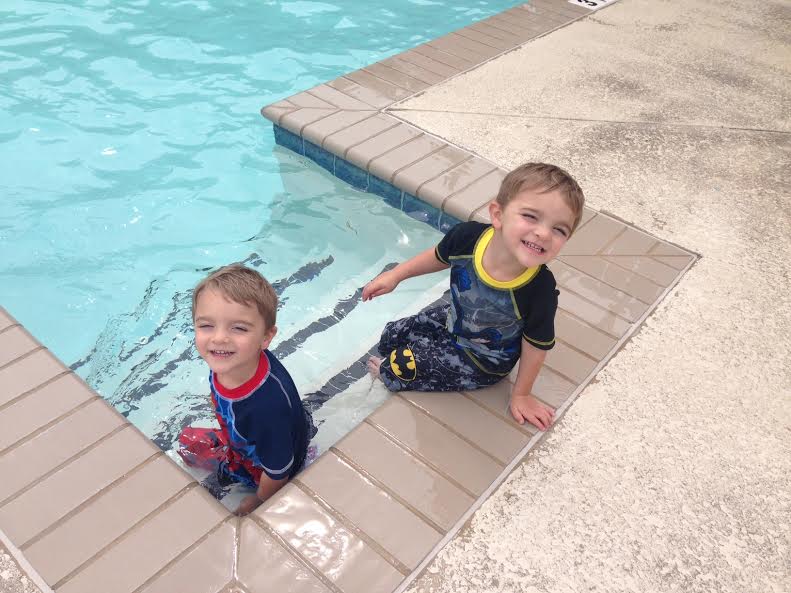
by Rachel Toalson | My Good Journey
A few days ago, we packed up in our minivan, every seat in this eight-capacity vehicle occupied, and went to Family Camp.
Family Camp is a place we have been four years running—a retreat over a three-day weekend where families can take time to reconnect, play together and rest.
We usually are the youngest family there.
It took me a while to figure this out. The camp, with its canoe capabilities and its swimming pool with a slide and its large wooden playground, seemed like it would appeal to parents of kids as young as ours.
And then I remembered the packing and the traveling and all of the logistics must be worked out to successfully road-trip with young children.
It’s exhausting.
The day we left, we had plans to leave right after the baby ate, which was usually around 3 p.m. It was only a 2.5-hour drive, so we should have been able to make it before the baby needed to eat again.
Except my husband didn’t start packing the car until I sat down to feed the baby, and it took a whole hour to fit everything inside the crammed-full car.
Except two minutes down the road one of the bigger boys said he needed to go potty, and we knew he wasn’t joking, and then everyone else, of course, said they needed to go, too, because it meant a break from the car (already).
Except we ran into torrential rain and heavy traffic.
A 2.5-hour road trip turned into a six-hour drive.
By the end of it, our kids were whining, the baby was screaming and I said we would never, ever do this again, because it was just.too.hard.
And it’s true. It was hard. Even the retreat was hard, because 3-year-old twins don’t make anything easy.
But the time spent away was good for us. It was good for our family. The 8-year-old learned how to row a canoe with his daddy. The 6-year-old strung beads and blessed all the mothers at the retreat with a pretty nametag necklace. The 4-year-old found a Batman mask in the treasure box set out the first day and wore it for the entire weekend. The twins painted pictures they never would have painted at home because it was so messy and turned their faces black.
But it was camp, and it was fun, and it was so good to take a weekend to just enjoy each other.
Sometimes the hardest parts are the parts that turn out to be the most life-changing parts.
When we are the parents of young children, it can feel almost impossible to go anywhere, because there is so much to pack and so many unknowns, and the kids will be in the car for so long, and we’ll probably go crazy, and what about the routine?
But sometimes it’s good for us to throw out that routine and accept the unexpected and go a little crazy, because there is little-boy pride in rowing across an entire pond, and there is little-boy excitement at having mastered that humongous twisty slide into water, alone, and there is little-boy joy in having made something beautiful for other people.
Sure, it took an hour to fit all those suitcases around legs and seats and a baby swing. Sure, that trip didn’t turn out exactly the way we planned. Sure, the kids drove us crazy asking every other minute how much longer it would be, but as soon as our car pulled into camp and they read the front sign, they started shaking the back end of the car they were so excited.
It was that minute I felt glad we had braved a road trip with six kids.
To make traveling with young kids a little easier, try this:
1. Bring along some audio books. We checked out some classics: How to Eat Fried Worms, There’s a Boy in the Girls’ Bathroom, Peter Pan, and listened to them during the trip (Tip: Always bring more than you think you need, in case of torrential rains and heavy traffic). Our boys love listening to stories when we’re traveling, and the parents get to listen, too.
2. Give them a small travel kit that’s only used during trips. When we made the 26-hour trip to Florida to visit family, we got each of the boys a new composition book and a small container of crayons and set them free. The 3-year-olds drew one line on every page. The 6-year-old drew works of art and colored them in. The 8-year-old took notes about each state we passed through and called it his Travel Diary. It still sits in his closet, with the date and time we drove up to his grandpa’s house. It’s a great memory for him.
3. Play car games. We all know the typical ones: I Spy or Shapes in the Clouds or Road Trip Bingo. For variety try this one:
Word Association Game: One person picks a word, another says the first word that comes to mind based on the first person’s word. (Example: Person 1 says “Banana.” Person 2 says “Yellow.” Person 3 says “Taxi.”) This can get hilarious with young ones.

by Rachel Toalson | This Writer Life
That’s the question I recently asked of Marcy Lytle, founder of A Bundle of THYME online women’s magazine (well, there were more, of course). In this interview, Marcy shares some wisdom about starting an online magazine, tips and tricks and advice she wishes she’d known before launching.
RT: You are a former math teacher and are now the author of two books and the owner of an online magazine. Tell us about that transition. What made you decide to pursue writing and publishing instead of teaching?
ML: When my kids were small I wrote my own devotions for our family, because I couldn’t really find a book in the stores that kept us all awake! We had hands-on lessons using things we found in the house. Several friends asked if they could receive them too. So after a few years of sending those out, I had enough for a book and contacted a few publishers—and found one interested in publishing. I’ve always loved writing but became a math teacher because I loved numbers too, and there was a need for them in the school system. However, writing is so creative and fun, I’m glad I finally am able to have an outlet for it. After publishing the first book, I took out an ad in a faith magazine, and then they asked me to become the editor. I enjoyed the editing side as well as the creative side—so I was hooked!
RT: When was the first time you thought about starting your own online women’s magazine?
ML: After writing and editing for two magazines for a few years, they both folded, due to expense in publishing for one (it was an actual paper magazine) and expense for salaries in the other (it was online). I began thinking. I have also worked for a magazine subscription agency (family owned) for years, and I receive about a dozen magazines that I love to read. With the relationships I had made on those two magazines, with some other creative writers, I asked if they would be interested in contributing, and they were! One day I woke up with the whole concept of THYME and in about two months’ time we published our first issue online.
RT: What made you want to venture into the online publishing world?
ML: I saw all of the time and expense it took to put together a paper magazine and distribute it. It was all-consuming. I also noticed in my work that many magazines were going totally digital. There was no way I could publish a paper magazine without quitting all I was doing and with some kind of major investment, so digital was a no-brainer way to go.
RT: What kind of work did it take, initially, to get the magazine off the ground?
ML: The hardest part was getting the website up and running and making it user-friendly yet attractive. My daughter had expertise in that area, and she helped me. The first year, I’d say, we were constantly changing, adding, deleting and improving the website itself. So many options and ideas to try out there!
RT: Tell us about A Bundle of T-H-Y-M-E. What’s the significance of its name? Why did you choose women as the main audience? What hole in the online publishing world did you hope it would fill?
ML: Honestly, I prayed and woke up with the herb thyme on my mind and looked up its history. It was actually given to people in bundles to offer them courage way back in history. That seemed like exactly what I wanted to do—offer women courage to have fun, a better marriage, parenting tips, more knowledge of relationship with God, etc. I sat down and came up with the acronym T-H-Y-M-E – tips, home, you, marriage, encouragement—which addressed each category—AND the ladies I had writing all had things to write about in those categories! I chose women because that’s who I had worked with, it’s who I wanted to speak to, and it’s what I knew about – because I’m a woman. I looked at online magazines and saw several faith-based magazines but none quite like ours—with practical ideas and spiritual in the same issue. I wanted to speak to both.
RT: What do you do on a daily basis to keep THYME magazine running smoothly?
ML: I have a whole schedule—from writing, to editing, to creating the pages, finding photos, copying and pasting the articles, aligning, linking, and proofing over and over again. Since we publish monthly, I have those things spread out into four weeks and do a little each week, until the magazine is complete—and oh that’s so fun to see it!
RT: How do you promote the magazine and its articles? What are some of the most effective promotional strategies you’ve used?
ML: I use Facebook, Twitter, Instagram, and I’ve taken out a few ads, as well as placed some on Facebook, and have cards made up that I hand out, as well. I’ve promoted it also by sponsoring a Noonday show and other markets where fair trade items are sold. THYME has a booth to help out, and it advertises our magazine. I think the most effective has been on my own personal page and by word of mouth from friends liking, sharing and posting. I don’t really know or have the tools to tell how other promotions have really worked. The hardest part of this whole process is being one person, needing to work another job, and do too much in 24 hours a day!
RT: What have been some of the greatest benefits to running your own magazine?
ML: I love knowing that women are reading and being blessed in their homes, their personal walk with God, their marriages, and trying out new and creative things just for fun. And I absolutely love the writers who write with me and enjoy reading their pieces, as well as writing my own. Writing is very fulfilling, creatively. And it helps when others are blessed.
RT: What have been some of the biggest challenges?
ML: Time and money. It costs to run a website and advertise, and I’d like to pay my writers but I don’t. I don’t bring in very much income at all, and I spend more than I make. I’ve tried several different ways to make money (asking for advertisers to pay monthly, affiliate advertising, and even donations) but I’m not one who pushes people (never liked marketing pushy people) and I don’t want to charge for my magazine, so here I sit publishing it as a ministry, for now…
RT: What do you hope for your magazine’s future?
ML: I’d love to see it grow to have more readers, but I’m trying not to focus on the numbers—that stresses me out. And I’d love to make money to pay my writers. They’re awesome and I’d love to give them something!
RT: What have you learned about online magazines since you started THYME that might be helpful to others who are considering starting an online magazine?
ML: It’s hard work, and if you constantly focus on the accolades or comments from people, it will zap the joy of just writing and sharing . If you know you’re supposed to do it, go for it, and let it grow naturally…and pray a lot…for provision. I prayed for a photographer and we now have one—and when I’ve needed new writers they’ve always surfaced and always had something THYME needed. It’s pretty cool to see that unfold.
RT: What would you do differently if you had the chance?
ML: Not worry so much, and just write.
RT: What advice would you give to those who are interested in running an online magazine?
ML: Try it, and if you find out any cool tips share them with me. If you’re out to make money, count the cost before you begin and get things into place. Make sure that first issue is awesome with no error, so readers will come back a second and a third and a fourth, etc. Stay on top of your schedule, don’t let your issue ever be late, make your readers know they can count on it when you say it’s coming… and finally, enjoy the ride…
(I’d also say to attend webinars or seminars about marketing a website BEFORE you begin. It’s crazy how much there is to know…especially about Facebook – they watch your posts and limit LIKES and all sorts of things, trying to force you to advertise…)
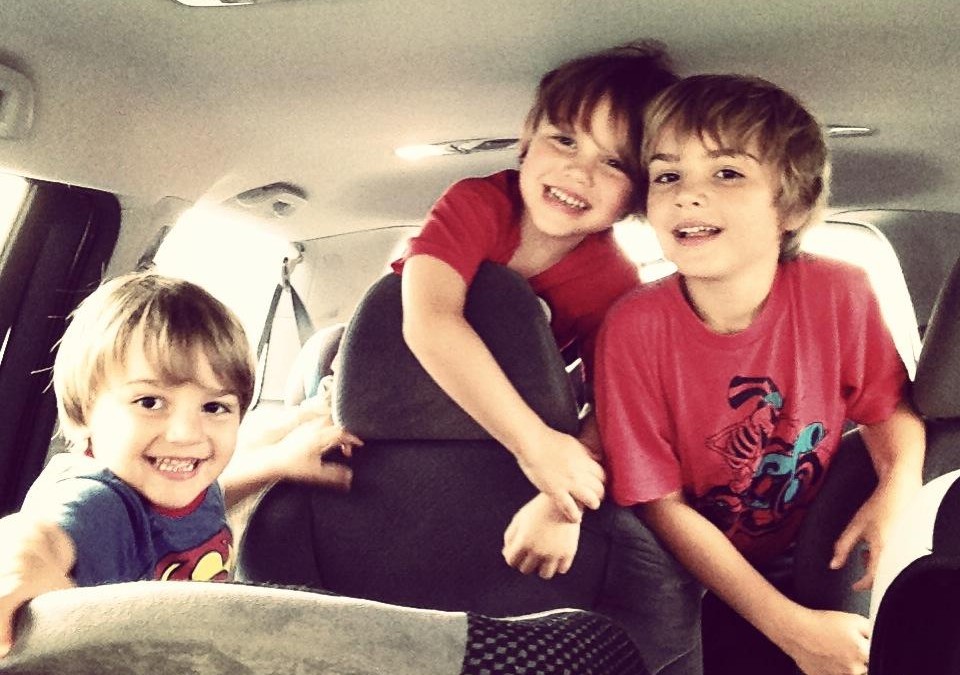
by Rachel Toalson | General Blog
We’re finally all packed up, and everyone is buckled and already said their piece about how Mama’s driving (because I never choose to), and Daddy has his laptop open, ready to work.
We’re going to get moving, after two hours of trying.
That’s right. It takes two hours just to leave the house.
And then.
Then I turn on the car, and the gas light is on.
Son of a—
I know what this means. A stop. A stop that will turn into a potty break that will turn into five potty breaks that will turn into thirty minutes (or more!) of wasted time.
It’s only a three-hour trip. It will take us five.
When we stop, after I’ve huffed and puffed about how someone should fill up the car once in a while and why can’t whoever was driving it last just fill it up before the gas light comes on (pretty sure it was me, that day I was running late to get dinner started and the three older boys had just effectively made me lose my mind fighting over two computers in the library, so I didn’t want to stay in the car with them one second longer), I tell them we are NOT getting out to potty, because this is not a scheduled potty break. This is just an inconvenient, necessary stop.
Scheduled potty breaks happen when the baby needs to eat.
“But I really need to go!” the 8-year-old says. It’s been a whopping three minutes since we left.
“Did you go before you left, like I told you?” I say.
“I didn’t have to go then,” he says.
Welp, you don’t have to go now, either.
There are so many kids. It’s like a field trip traveling with all these boys. When one needs to potty, they all do. When one falls asleep, the others don’t. They just get louder.
Every two minutes a different one asks, “Are we almost there?”
We’re not even out of the neighborhood yet.
At first we answered no. Then we answered yes. Then we tried to ignore it. Then we told them to stop asking. Then we told them the truth.
“Two more hours.”
“One hour and forty-eight minutes.”
“One hour and fifty-six minutes.”
Then we turned it into math practice.
“One hour and fifty-four minutes. How many minutes have passed since you last asked?”
“One hour and fifty-two minutes. Do you notice a pattern between your questions?”
(Even that didn’t discourage them.)
In the end, this is the question that will break us. It’s the one that will make my husband and me look at each other with those crazy eyes and mouth, “Never, ever, ever, ever, ever, ever, ever, EVER again,” so the kids can’t hear.
I took some traveling notes I wanted to make sure to remember next time I think it would be a good idea to pack six boys into the van and travel more than the five miles to the grocery store:
Don’t even think about it, woman. But if you do, here are some tips.
1. Bring some oversized cups.
It’s never too early for boys to learn the art of peeing in cups. When our 3-year-old twins are playing free at home, they will go hours without having to visit the restroom. When they’re in the car, their bladders shrink to about the size of a peanut. They need to pee every half hour. So make it a game: They have to pee in a cup without unbuckling.
On second thought, that’s a losing game, Mama.
2. Bring treats for every mile you go without hearing, “Are we almost there?”
This one will drive you absolutely bonkers, because when you have multiple children, they each take turns asking, as if the answer you gave their brother just wasn’t good enough for them. As if their asking may change something. As if something has changed in one hundred twenty seconds.
One kid might ask it 2,000 times. Six kids ask it 13 billion times. So reward them for keeping their mouths shut.
3. Don’t bother putting shoes on the 3-year-olds.
They take them off as soon as they get in the car anyway, and they’ll get buried under all the jackets that somehow keep ending up in the car even though it’s 200 degrees outside. Some of them will get shuffled under seats. One will probably fall out the door and you won’t notice (true story). You’ll waste way too much time (and remember: minutes are precious when traveling with kids) looking for shoes, especially when one has gone missing because it was left in the last town. So just don’t bother.
4. Bring audio books. (They’re more for you than for the kids.)
They’re so the next time they ask, “Are we almost there?” you can say, “I’m trying to listen to the story.” They’re so when they say they need to go to the potty again you can say, “Let’s wait until this story is over” (they don’t have to know that will be another hour). They’re so when they’re rocking the back of the car because they want to move it faster, you can retreat into your own world and try to ignore the way the van is not moving any faster—probably slower, because everything is slower with children when children try to help.
5. DON’T INTRODUCE I SPY. OR KNOCK KNOCK JOKES.
Notice this one is in caps. There’s a good reason for that. Three thousand rounds of I Spy. Five hundred knock knock jokes. Do you remember? Of course you do. Your eye is still twitching.
The “Are we almost there” question is nothing compared to this. So just close your mouth and keep your eyes on the road.
6. Use a better reservation system than the husband.
“Shoot,” he says when we’re turning into our destination. The sky fell dark hours ago, the kids are tired and I’m feeling especially grumpy.
“What?” I say.
“Nevermind,” he says. But I know. There is always a reason he says what he says.
“What?” I say again. I’ve got a bad feeling about this.
“Well, I can’t remember which condo is ours.”
At this point nothing could really surprise me. I don’t even blow up or rant about how could you not write it down and do I have to do everything and how about we just turn around and go back home. I’m too tired for that. So I just put my head down on the steering wheel and sigh a long, long sigh.
“They left the key under the mat,” he says, looking at the row of fifty condos.
“Have fun looking,” I say.
At the last minute he remembers. It was the first one we passed through the gate.
We all pile into the 500-square-foot condo that looked bigger in the online pictures and collapse on our bed.
Nothing like traveling together to ensure a good nights’ sleep.
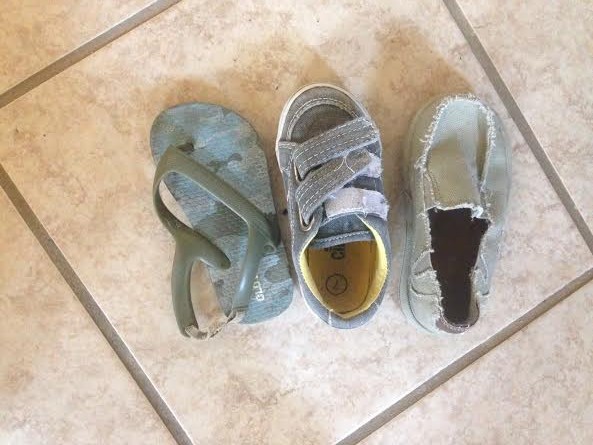
by Rachel Toalson | Messy Mondays
It doesn’t matter if they put their shoes in the designated basket beside the front door as soon as they walk in. It doesn’t matter if just three seconds ago there was a left shoe and a right shoe. It doesn’t matter if they were wearing their shoes thirty seconds ago.
When we are ready to leave the house, we will always be searching for shoes. Always. I know it’s an absolute, and I’ve said it twice even, but this is what eight years of parenting have taught me: You will always be looking for shoes. And they hide well. They hide impossibly well.
We don’t have high standards. We just want them to wear shoes. We don’t care if one shoe is green and another is black. We don’t care if one is a flip flop and the other is a tennis shoe. We don’t care.
But the thing about mismatched shoes is there has to be a left one and there has to be a right one.
We tried to leave the house today, because we don’t have any food in our refrigerator and I thought a trip to the store would probably be a good idea (even though it’s not, because kids). I tried my best for thirty whole minutes. I only have three kids here right now, because grandparents are watching the other three. It should have been (comparatively) easy.
Except this is all I could find. Mismatched shoes, and they were all the same foot. I can’t work with this.
And since I’m looking for every excuse not to haul 3-year-old twins and a five-month-old to the grocery store, we just stayed home.
Oh, well. Who needs food?

by Rachel Toalson | Wing Chair Musings
Five years ago you slid into our lives on a hot and humid summer day. You stared at us with those big eyes I knew would stay brown from the very beginning, and I fell immediately and deeply in love.
We spent those first few nights just the two of us, because your daddy was gone and your older brothers were sleeping. And at first I was terrified of that alone-time, but now, looking back, I’m so thankful we had those lonely hours and lazy mornings. I got a solid Mama’s boy out of them.
Now you are growing up. Five years old. In another six weeks you will head off to school, like your older brothers ahead of you, and I will feel the hole in our home like it lives in me, an ache all through my bones. Yet another one, off to kindergarten.
How I wish that time did not fly so fast, that I could keep you here with me for just a while longer. Just a moment. Just a day. Just a year or two or fifteen. This, though, is one more step along the road to freedom.
I am not yet ready to let you go.
Life doesn’t ever ask if we’re ready. It just marches on.
You have always been a sweet, charming, hilarious little boy, except when you get in trouble. Then you hide. Then you retreat into your own safe place. Then you don’t want to face the failure.
You know what, son? You’re not alone in that hiding place. Because I know. I know how scary it is to admit you’ve done something wrong. To admit you’ve failed, just this smallest bit. To see what waits on the other side of admission.
I used to hide, too. Back when I was your age, back when I was older, back when I was a full grown adult, about to get married. I used to pretend that I never made mistakes, that I always only did good. I tried so hard to be perfect.
This is a losing game, love. I want you to learn that sooner than I did.
Sometimes we feel the need to hide because we believe we won’t be loved if we’re not perfect. Sometimes we think our mistakes define who we are. Sometimes we’re afraid of the consequences of those mistakes.
Before you go to school, where rewards and punishments have a way of telling you who you should be, I want you to know this in all the deepest places:
Bad decisions don’t make you bad.
It’s easy to forget this, because of the people at the other end of our mistakes.
Sometimes they make us feel stupid for thinking that could ever have been a good idea. Sometimes they’ve had a rough day and our bad decision and its ripple effect is just one more notch on the line of the day’s disappointments. Sometimes what they say, the way they make us feel, how they react instead of respond, can make us start to believe we’re bad. Like we should be better, know better, do better.
That we are a disappointment, through and through.
I want you to know you’re not. I want you to know that there is absolutely nothing on this earth you could do, as horrible as it may be, that would make me or your daddy love you any less. I love you because you are here, because you are you, because you are mine, at least for this short time.
You are a good boy who sometimes forgets who he is. When you forget who you are, you lash out at that annoying little brother. When you forget who you are, you bang your feet against the blinds because I won’t let you go downstairs to play during Quiet Time. When you forget who you are, you bury your face in a couch so you don’t have to see your brother crying because you said you didn’t want to be his friend anymore.
But every time you do something you know is wrong, or you act impulsively instead of cautiously, or you lash out in anger, I know the truth: You’re better than those mistakes. You have forgotten who you are, and it’s my job to help you remember.
So, as you prepare for a career in public school, I want you to know that the days you bring home your red folder, and the behavior chart has a green smiley face that says you behaved well, we are going to celebrate.
But the days you bring home a behavior chart with a yellow face or a red note scrawled across today’s square, we are still going to celebrate—because those are the times we get to remind you who you are. Those are the times we get to speak life into your broken places. Those are the times we get to teach and steer and love in a way that is more than words.
Those are the times we get to say:
Bad decisions don’t make you bad.
Bad behavior doesn’t make you bad.
Bad thoughts don’t make you bad.
Who we are changes what we do, but what we do doesn’t change who we are.
We get really good at punishing ourselves when we’ve done something wrong. We get good at analyzing our motivations and concluding that we’re just bad people. We get good at wishing we could just be better.
It’s not an easy habit to break.
So it’s important to remember this:
Who are we without all the armor covering our weak places? Who are we when we fail? Who are we when we forget our identity?
We are still worthy people.
That will never change.
Hear me, son. THAT WILL NEVER CHANGE.
As we come up on your fifth birthday, I want you to know, yet again, that your daddy and I love you as much as we possibly could. We are in your corner, always. We are waiting with great anticipation to see who you become in these years to come, because who you are is already amazing.
Happy birthday, love, May your next year be filled with opportunities to remember that what you do doesn’t change who you are.

by Rachel Toalson | On My Shelf
On my shelf this week:
The Way to Write for Children: An Introduction to the Craft of Writing Children’s Literature, by Joan Aiken
The Art of Work: A Proven Path to Discovering What You Were Meant To Do, by Jeff Goins
God Help the Child, by Toni Morrison
This week I’m diving into a children’s writing instruction book, just to hone my craft, reading a philosophical figure-out-what-you’re-supposed-to-do book (even though I already know what I was made to do) and reading the newest from one of my favorite authors—and I must say she had me hooked on page 1. Toni Morrison is a master storyteller. I would like to be her when I grow up.
Best quotes so far:
“The first book that a child reads has colossal impact.”
Joan Aiken
“Because children don’t criticize, don’t enjoy criticism, and read wholly for the plot, it is therefore the writer’s duty to keep the narrative in a children’s story as smooth as possible, not to interrupt it with asides to the reader, authorial comments, or any other hindrances.”
Joan Aiken
“A calling is what you have when you look back at your life and make sense of what it’s been trying to teach you all along.”
Jeff Goins
“What it takes to become great at your craft is practice, but not just any practice—the kind that hurts, that stretches and grows you.”
Jeff Goins
“I don’t think many people appreciate silence or realize that it is as close to music as you can get.”
Toni Morrison
“What you do to children matters. And they might never forget.”
Read any of these? Tell us what you thought.

by Rachel Toalson | Fiction in Forty
They promised me things, see? Fame. Fortune. A name for myself. So I posed and starved and let them take pictures, let them sell little pieces of me, and for what?
Nothing, it turns out. Nothing but another pretty face.
Ongoing challenge: Find (or take) a picture. Write exactly 40 words about it. Post.
(Great practice for brevity.)
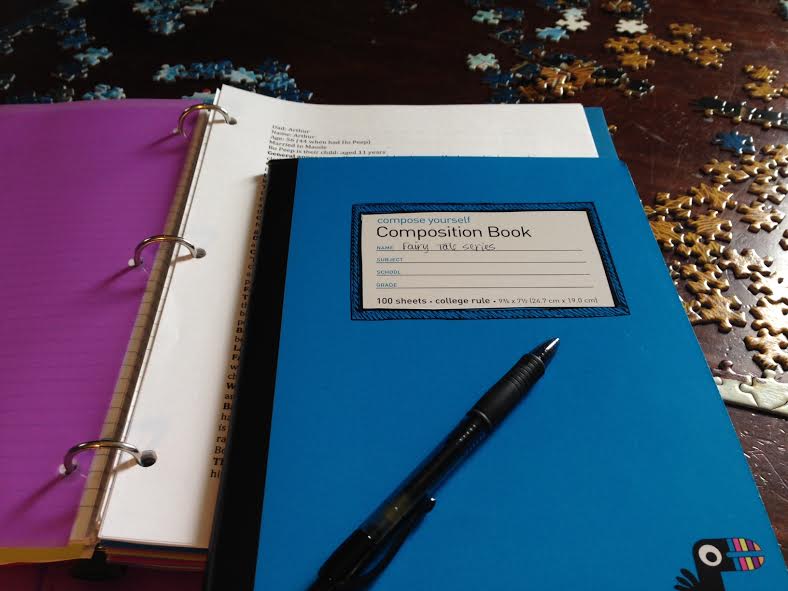
by Rachel Toalson | This Writer Life
But I just don’t have the time.
But I just don’t know what to do.
But I’m just not a writer.
I hear a whole lot of buts from people who don’t think they have what it takes to be a writer—whether it’s the time, the ideas or the talent.
So many writers have grand plans for stories they want to write or projects they’d like to someday start or the career they’d like to pursue instead of the one they’re stuck in right now.
Those excuses can seem like a period at the end of the sentence, but they’re really only parentheticals.
Writer parents are working with an incredible amount of restraint—time and location and ability to think straight for any extended period of time.
In 2013, Forbes Magazine published some data researchers found when conducting a study of “award-winning work from 1.7 million people.” They found that “people who create new value on the job are often inspired by their constraints.”
What this means for us: Constraints can be beneficial.
There is a catch here, though. (Of course there is.)
The catch lies in the way we think about our constraints: not as “barriers to your ability to innovate, but instead as a puzzle that holds the opportunity for creativity and Great Work.”
So everything in our lives becomes a puzzle. The lack of time, the lack of resources, the lack of babysitting. It’s all a puzzle, waiting to be figured out, not a limiting permanent marker line through our dreams.
But I just don’t have the time.
Maybe I can find some.
And then look at all the spaces, where time may be waiting for you to pick up a pen and a notebook and just jot down notes or whole essays or 200 words or 1,500 words.
But I just don’t have the resources.
Maybe I can figure out how to get some.
But I just don’t know what to do.
Maybe I can figure it out if I had a little time to brainstorm.
But I’m just not a writer.
Maybe I could become one.
“Constraints give us a starting point and some building blocks to work with—a problem to solve, an innovative twist to be revealed, or a person to please,” says David Sturt, author of Great Work: How to Make a Difference People Love. “And it doesn’t matter how tightly constrained we feel. The world is filled with amazing possibilities from limited resources and elements.”
Consider colors, he said. Every single variation of color comes from only three: red, yellow and blue. Every song starts with the same twelve notes on the chromatic scale. Everything on the planet is made from only 118 known chemical elements.
Constraints are a “starting point for seemingly endless creativity and possibility,” Sturt said.
So when it comes to writing, start with the constraints. Start with the limited amount of time. Start with the limited ideas. Start with the limited expertise, and then produce your masterpiece. Start a new project. Do the work.
We have lots of excuses for not chasing our dreams. And some of those excuses are really legitimate, because of course the kids need to be fed and put down to bed, and of course they get sick and of course living with children makes life unpredictable and wild, but those constraints can become our greatest catalysts, if we’ll let them.
Constraints are hidden in our buts. We can turn those buts around. We can make them work for us. We can make them help us create the most creative work yet.
Here are some things we can do:
1. Write down your buts. Be honest. Write down everything that’s keeping you from doing what you really want to do—whether it’s starting a blog or launching an online magazine or working on a new project. And then turn your buts into opportunities.
(But I can’t write. But I can learn to.
But someone else is already doing it. But I can add my own unique contribution.
But I’m not prepared for the risk. But I can prepare myself as well as I possibly can.)
2. When a new but comes calling, see it as an opportunity, not as a limit. Constraints can be difficult to work around, but they don’t have to dictate what we do and what we don’t do. We can brave through them.
3. Keep a log of what you have accomplished, especially when the constraints were still in place. This can be valuable. At the end of last year, I felt like I hadn’t really accomplished all that much. And then I realized, after looking back at my work log, that I had accomplished far more than I remembered. Memory can be faulty, so it’s good to have proof.











